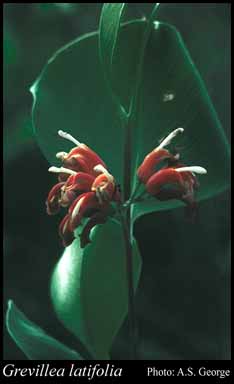- Reference
- W.Australia Forests Dept.Bull. 32:43 (1923)
- Conservation Code
- Priority Two
- Naturalised Status
- Native to Western Australia
- Name Status
- Current
Single- to many-stemmed, lignotuberous shrub, 0.6-2.5(-4) m high. Fl. red/pink/yellow, Mar to Apr or Jun to Sep or Dec. Sandy soils on sandstone, laterite or quartzite.

Scientific Description
Shrubs, 1-2 m high; branchlets glabrous or hairy, not glaucous. Leaves alternate, 70-160 mm long, 70-135 mm wide, glabrous; lamina flat, widest around the middle, entire, the margins flat. Inflorescences terminal, red or pink; pedicels 6-8 mm long. Perianth 12-15 mm long; tepals some joined and some free after flower opens, glabrous; ovary glabrous, stipitate, the stipe 2-4 mm long; pistil 12-17 mm long, white, pollen presenter lateral, style glabrous. Follicles glabrous, not viscid, dehiscent, 16-19 mm long. Flowers in March, April, May, June, July, August or September. Occurs in the Northern (N) Botanical Province(s), in the Northern Kimberley (NK) or Central Kimberley (CK) IBRA subregion(s). : Conservation code Priority Two (P2).
Distribution
- IBRA Regions
- Central Kimberley, Northern Kimberley.
- IBRA Subregions
- Berkeley, Mitchell, Pentecost.
- Local Government Areas (LGAs)
- Derby-West Kimberley, Wyndham-East Kimberley.